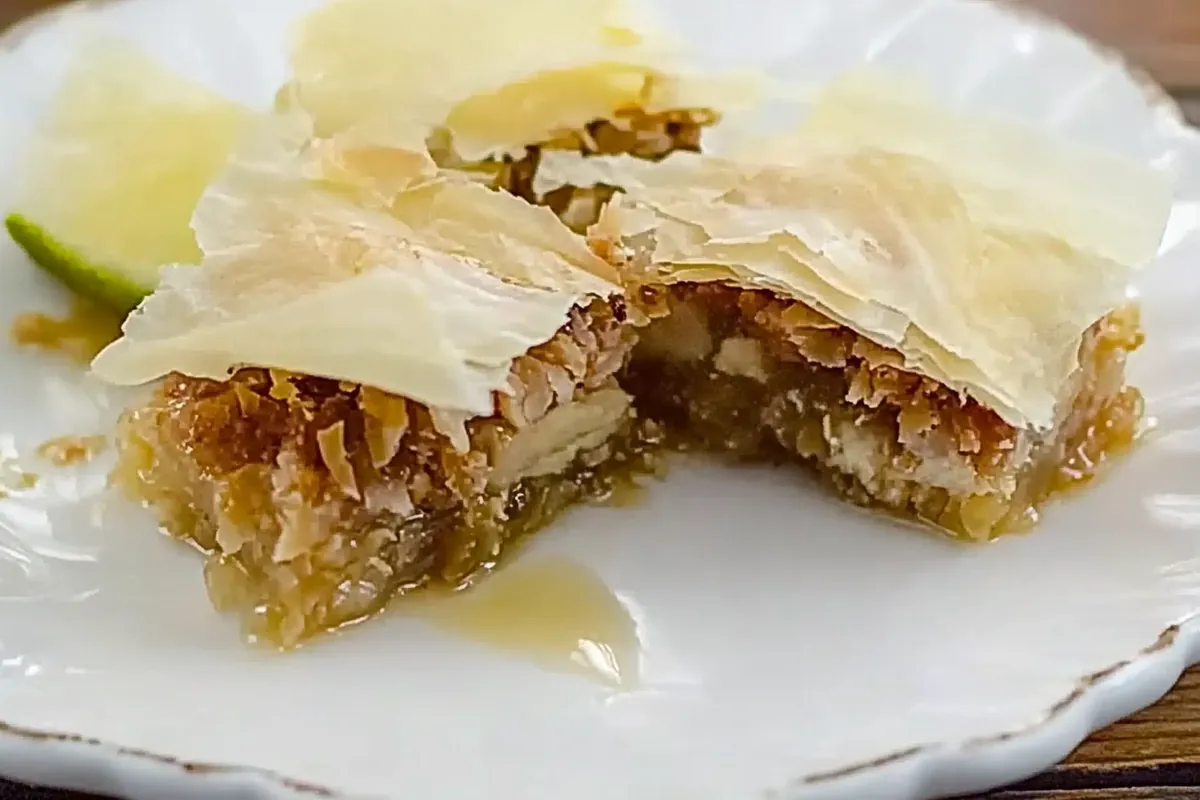Greek desserts offer a truly wonderful culinary adventure. These sweet treats, often rich with honey and nuts, provide a delicious glimpse into Greek culture. They range from simple delights to elaborate pastries. This exploration will uncover some of the most amazing Greek desserts.
Exploring the World of Greek Desserts
Greek desserts are known for their unique flavors and textures. Many recipes incorporate local ingredients like phyllo dough, honey, and nuts. These treats are not just food; they’re a part of Greek heritage. Each dessert tells a story through its flavors and preparation. They bring families together and mark special occasions.
Phyllo-Based Wonders
Phyllo dough is a staple in many Greek pastries. Its delicate layers create a light and flaky texture. Baklava, a famous Greek dessert, uses phyllo dough extensively. It’s soaked in sweet syrup, often with honey, and it’s filled with chopped nuts. Another popular choice is galaktoboureko, a creamy custard pie with a similar phyllo base.
Honey and Nut Delights
Honey and nuts play a crucial role in Greek sweets. They provide natural sweetness and rich, earthy flavors. Many desserts feature walnuts, almonds, or pistachios, combined with local honey. These ingredients not only taste amazing but also reflect the natural bounty of the Greek landscape. This gives these desserts a special character.
Image Placeholder: alt text “assorted greek desserts”, showing a variety of sweets with nuts and honey
Creamy Custards and Puddings
Beyond phyllo, Greek desserts feature custards and puddings. Rice pudding, or rizogalo, is a comforting favorite. It’s often flavored with cinnamon and vanilla. Another beloved custard dessert is loukoumades—small, fried doughnuts drizzled with honey and sprinkled with cinnamon. These rich custards and puddings offer a comforting taste of Greece.
The Significance of Greek Desserts
Greek desserts hold deep cultural significance. They’re a key part of celebrations, family gatherings, and religious holidays. For example, melomakarona, honey cookies, are popular during Christmas. They highlight the importance of food in Greek traditions. The act of sharing these desserts enhances the feeling of community.
Festive Treats
Many Greek desserts are tied to specific festivals. During Easter, tsoureki, a sweet bread, is prominently featured. This underscores how dessert connects to larger cultural moments. The creation and sharing of these sweets are not just about eating; it’s about celebrating. These traditions have been passed down through generations.
Family Recipes
Family recipes are the heart of Greek dessert making. Each family has its own special way of making baklava or galaktoboureko, like this banana bread recipe with 2 bananas. These cherished recipes have stood the test of time. Families continue to bake these desserts to connect with their heritage. The love and care poured into these desserts shine through in each bite.
Image Placeholder: “a close up photo of baklava”, showcasing the flaky layers and syrup.
Everyday Pleasures
Greek desserts are not only for special occasions. Many simpler sweets are enjoyed as everyday treats. A simple yogurt with honey makes a refreshing and delicious dessert. These daily desserts highlight the simple pleasures of Greek life. They’re a quick and easy way to savor a sweet moment.
The 9 Common Greek Desserts You Must Try
Exploring Greek desserts reveals a variety of flavors and textures. Some stand out as particularly popular and beloved. These nine common desserts are a great starting point for anyone curious about Greek cuisine. Each one offers a unique taste of Greece.
Baklava
Baklava is perhaps the most famous of all Greek desserts. It features layers of flaky phyllo dough, chopped nuts, and sweet syrup. Its rich and sticky texture makes it an unforgettable experience, similar to the texture of this strawberry poke cake recipe. The combination of flavors is complex yet satisfying. This is a dessert that everyone should try at least once.
Galaktoboureko
Galaktoboureko is a creamy custard pie baked with layers of phyllo. The creamy custard is smooth and comforting. The contrast with the flaky crust makes it especially delicious. The subtle sweetness complements any meal. This dessert is perfect for those who love custard and textures.
Loukoumades
Loukoumades are small, deep-fried doughnuts that are then soaked in honey and sprinkled with cinnamon. They are crispy on the outside and soft on the inside. Their golden brown color adds to their appeal. These bite-sized treats are often a crowd-pleaser. They offer a simple yet delicious taste of Greece.
Melomakarona
Melomakarona are honey cookies often enjoyed during Christmas. They are soft and spiced, with a nutty flavor. The texture is slightly crumbly but very pleasing. The hint of citrus enhances their overall taste. They’re a perfect treat to share during the festive season.
Kourabiedes
Kourabiedes are buttery almond cookies that are dusted with powdered sugar. They have a melt-in-your-mouth texture. The almond flavor is both delicate and rich. These cookies are popular during celebrations but enjoyable anytime. Their simple elegance makes them a favorite.
Kataifi
Kataifi is a dessert made with shredded phyllo dough, nuts, and syrup. It has a unique texture due to the shredded phyllo. It is often compared to nests due to its shape. The sweet syrup enhances the nutty flavor and adds a sticky quality. This is a dessert that showcases creativity in Greek pastry-making.
Rizogalo
Rizogalo is a creamy rice pudding flavored with cinnamon and vanilla. It’s a comforting, simple dessert. The texture is smooth and the flavor is subtle yet satisfying. It can be served warm or cold, making it versatile. This is a good option for those who prefer a milder dessert.
Yogurt with Honey and Nuts
A simple but classic Greek dessert is thick Greek yogurt drizzled with honey and sprinkled with nuts. The tartness of the yogurt complements the sweetness of the honey. The nuts add a pleasant crunch. This is a refreshing and healthy option. It’s a testament to how simple ingredients can create a great treat.
Image Placeholder: “a bowl of greek yogurt with honey and walnuts”, emphasizing the simplicity and healthiness.
Tsoureki
Tsoureki is a sweet, braided bread often eaten during Easter. It’s light and fluffy, often flavored with mahlepi and mastic. The unique flavors and textures make it a special treat. It’s a symbol of celebration and family. This bread brings people together for Easter and is also enjoyed throughout the year.
Greek Desserts: Sweet Conclusions
The world of Greek desserts is rich and diverse. Each dessert has a unique story to tell. They reflect the culture, history, and traditions of Greece. From the flaky layers of baklava to the creamy texture of rizogalo, there’s something for everyone to enjoy. These desserts are not just a meal’s end; they are an experience. They showcase Greek hospitality and heritage. Exploring these sweet treats is a delicious way to connect with Greece. The use of local ingredients like honey and nuts makes these desserts truly special. So next time you crave something sweet, try a Greek dessert. You may just discover a new favorite.
Image Placeholder: “a display case filled with various greek pastries”, emphasizing the variety and appeal.
FAQ
What is a famous dessert in Greece?
Baklava is perhaps the most famous Greek dessert. It’s made with layers of phyllo dough, chopped nuts, and a sweet syrup, usually infused with honey. Its rich, sticky, and sweet profile makes it a beloved treat enjoyed across Greece and beyond. It is often served at celebrations and family gatherings.
What are traditional Greek pastries?
Traditional Greek pastries often feature phyllo dough, honey, and nuts. Popular examples include baklava, galaktoboureko, and kataifi. Many also incorporate ingredients such as semolina, cinnamon, and citrus zests. These pastries are typically baked and soaked in a sweet syrup. They vary in texture from flaky to creamy.
What are the 9 common desserts?
The nine common Greek desserts are baklava, galaktoboureko, loukoumades, melomakarona, kourabiedes, kataifi, rizogalo, yogurt with honey and nuts, and tsoureki. Each offers a unique combination of flavors and textures. These desserts are frequently enjoyed in Greece. They showcase the range of Greek sweet treats.
What desserts are served at Greek weddings?
Greek weddings often feature baklava, kourabiedes, and other traditional pastries. These sweets are typically served after the main meal. They symbolize the sweetness of marriage. Honey-based desserts, such as loukoumades, are also popular. They represent the joyful and festive atmosphere of the occasion.

